Brushing
Instructions on brushing your teeth
|
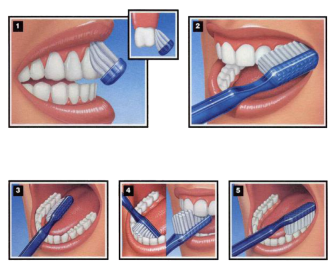
|
Which type of toothbrush is best?The best brushes are those that have the brush bristles parallel. Also the stem of the toothbrush should be parallel and in the same plane with the bristles of the brush. In cases of small mouths or intense vomiting reflex is good for the back teeth a children's toothbrush to be used which is smaller than that adults' one. |
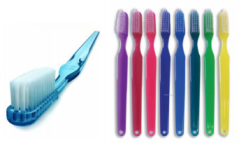
|
How often should you replace your toothbrush?
|

|
Instructions on how to floss
|
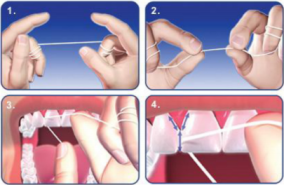
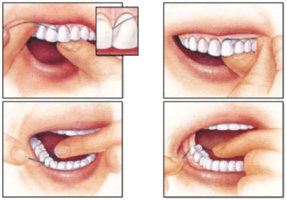
|
Children's oral health
| Milk teeth are the first generation teeth which appear in the mouth. They appear around the 6th month since birth and end at age 2 1/2 years (approximately). The deciduous teeth are twenty. Ten in the upper and ten in the lower jaw. |
Are milk teeth useful?The importance of milk teeth is big, for the proper development of the stomatognathic system of the child, chewing of food, communication, and appearance. Also - and this is something that many people ignore - they are absolutely necessary for maintaining the space for a proper eruption of permanent teeth. For these reasons, the belief that milk teeth are not important, because they are replaced with new, is completely wrong. |
Harmful oral habitsThey are habits that cause imbalance in muscle forces oraly and influence functions (chewing, speech, sensory) and subsequently the development and formation of the mouth and face. Such habits are finger suckling or use of a soother, oral breathing, the position of the tongue during swallowing, suckling the lower lip or tongue and biting of the lower lip, nails or hard objects. Avoiding such habits can be achieved with education and by using specific dental equipment suggested by your dentist. |
Do children get carries?Of course. Especially those who eat a lot of sweets, candy and sugary drinks. Although these are not the only causes for caries. The tooth structure determines the degree of their vulnerability to carries. The conformation of the first tooth starts in the third fetal month. So it is important that the diet of pregnant women is rich in proteins, vitamins (A, B, C, D) and minerals (calcium). Equally important is the diet of the children. The process continues until approximately 25 years of age, when the formation of the third molars (wisdom teeth) is completed. Brushing of the teeth and the first visit to the dentist should begin as soon as possible. Depending on the age of the child, toothpaste recommend by your dentist should be used. |
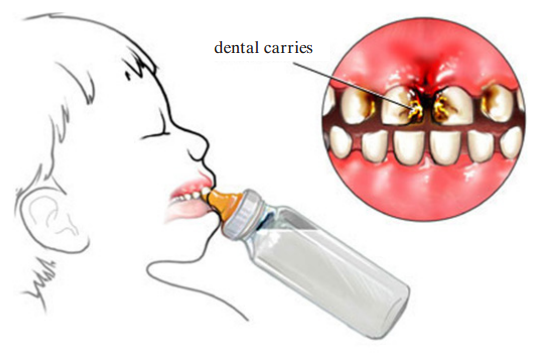
|
Dental carries
|
Dental caries is a disease of hard dental tissues characterized by demineralisation of the inorganic and organic tooth structure. It occupies the first place among the chronic human diseases. As it evolves, it destructs the teeth, making chewing difficult and alters aesthetically the oral cavity. Cavities seriously threaten the teeth. If you do not treat it, it can damage your teeth, cause inflamation or even necrosis to the sensitive nerves located in the teeth and create abscess i.e. endodontic infection. Abscess is treated only with endodontic therapy (root canal filing), surgery or tooth extraction. Further complication of the disease is the extension of inflammation in periapical tissues and possible effects on the general health of the body especially in people with a medical history. The occurrence of caries is linked to the simultaneous presence of three main causative agents:
|
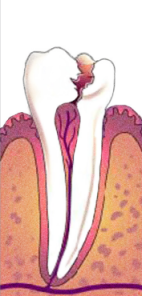
|
What parts of the tooth are affected by caries?First sites affected are the fissures and the grooves of the occlusal surface of the teeth. Change of color indicates tooth carries. Besides the chewing surfaces, carries starts from interproximal surfaces of teeth, where the teeth touch. |

|
Does carries cause tooth cavities?Carries does not cause any cavities immediately. The tissue damage caused by caries is irreversible when the development has reached the creation of the clinical picture of the cavity. When the dentine material is dissolved, the outer walls of the enamel break and a cavity appears on the tooth. This is already an advanced stage, probably accompanied by pain. Your dentist is able to recognize a carious tooth at a much earlier stage and prevent its evolution and the appearance of a cavity.
|
|
Does carries appears on teeth with fillings?Because many adults lacked the benefits of modern preventive dentistry (e.g. fluorosis) growing up, they often have a lot of dental fillings. Over time these fillings are weakened and tend to break, mainly on the line between filling and tooth. The bacterial plaque accumulates and is retained in tiny cracks creating acids and so beginning new carries. |
|
How can I prevent carries?
|
|
Gum diseases
GingivitisRefers to inflammatory processes caused most of the times due to the existence microbial agents as a result of lack or misapplication of oral hygiene. The lesions are confined to the free and interdental gingiva and are reversible. Typical indicators for the presence of gingivitis is bleeding during brushing or automatically and redness of the gingiva. |
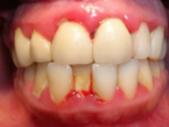
|
PeriodontitisIn most cases is the development of gingivitis to a disease causing irreversible effects such as loss of gums, bone loss which holds the teeth and loss of teeth at an advanced stage. With proper treatment we can stop the further development of periodontitis and preserve unaffected periodontal substances. |
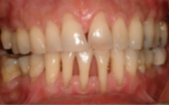
|
PreventionTo avoid appearance of gum diseases it is necessary to:
|
Maintenance instructions for prosthetic restorations
|
The prosthetic work that you carry in your mouth (either porcelain fixed bridge, or removable partial dentures) replace some natural teeth. The materials used are biocompatible and are not altered in the course of time. However, we must not forget that the prosthesis supported by natural teeth, which are living organisms and are threatened by diseases, both in themselves (caries) and the tissues that support them (periodontal disease). Indeed, the teeth supporting the prosthetic restoration are more at risk than other teeth as well beacuse they: (a) carry an increased bacterial load (the presence of foreign materials alter the microbial flora of the mouth), and (b) it is practically difficult to clean them. Your own role in the long-term success of prosthetic work is particularly important! To keep your natural teeth and therefore your prosthetic restorations healthy for many years, follow these guidelines:
|
Endodontic treatment (root canal treatment)
|
The treatment itself is painless. Between visits it is likely to experience some discomfort caused by irritation of the area around the tooth due to the required handling during treatment, or resurgence of old contamination which existed but was in recession. The discomfort varies and can be simple tooth sensitivity during chewing, feeling of heaviness or -rarely- swelling and pain in the affected region. In this case, follow the instructions below:
Symptoms that may occur between visits are not worrying about the fate of the tooth, or affect the outcome of treatment. |
Tooth extraction
Instructions before having a tooth extracted
|
Instructions after having a tooth extractedFor better healing and to prevent undesirable situations, please follow the instructions below:
|

